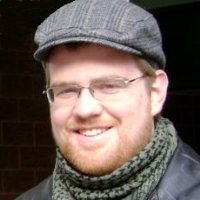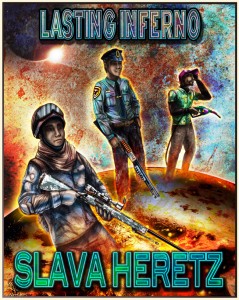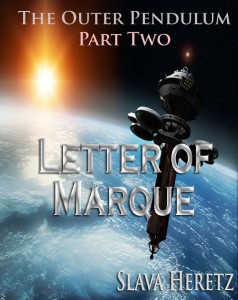Here is an interview with another fellow science fiction author I’ve been in touch with recently. He has had some very unique experiences in his life that I found quite interesting. So I thought a quick Q&A would be a good way to pry a bit 🙂 Joe has written several exceptional short stories and novels, including one which I got a chance to take a peek at — a space exploration tale called Genesis Earth. He also maintains a very good and informative blog at One Thousand and One Parsecs. So without further ado:
Tell me a little bit about yourself and how you got started writing science fiction.
Hi! My name is Joe Vasicek and I’ve been making up stories since I was old enough to know what a story is. I got hooked on science fiction when I saw Star Wars (I think I was seven or eight at the time), and I knew I would one day be a writer after I read Madeline L’Engle’s A Wrinkle In Time shortly thereafter. I don’t know how I knew, I just did.
I finished my first novel while attending college at Brigham Young University, where I studied political science and Middle Eastern studies & Arabic. I graduated 2010 and have since been working odd jobs while writing books and publishing them for the Kindle, Nook, and other ereaders.
You seem to have a strong interest in travel and middle eastern culture. Do you think this has shaped your style as a writer or influenced your fiction in any way?
Definitely! I think that exposure to any culture enriches your writing because it gives you so much more knowledge and experience to draw from. My writing has been enriched a great deal this way, not only from my travel experiences, but from my friendships with people of different cultures.
For example, I learned from a good Armenian friend of mine that in his part of the world, it’s customary for the mother of the groom to present a basket of apples to the mother of the bride the morning after the wedding. The Armenian culture places a high value on female virginity, and so this symbol of the bride’s purity is extremely important. For my forthcoming novel Desert Stars, I used that little detail in a wedding at the beginning of the book and made it part of a recurring theme, tying it closely with the questions of love and honor that the story raises.
Any upcoming projects?
Yep! My goal is to self-publish a minimum of two novels per year, so I’ve always got something coming out.
My next immediate release is Desert Stars, which I hope to have out before Christmas. It’s a story of adventure and romance on the fringes of an interstellar empire that has forgotten its holiest legend: the story of Earth. A young boy falls to a desert planet in an escape pod and is raised by the native tribesmen. To find out where he’s from, he feels he must journey to an ancient temple on the other side of the planet, dedicated to the memory of Earth.
When the sheikh learns of this, however, he sends one of his daughter with the boy to seduce him and shame him into coming back. The trouble is, she actually has feelings for him–so when love and honor clash, how can they face their destiny when it threatens to tear them apart?
Oh, and did I mention that there are space barbarians? Yes, the starfaring barbarian Hameji from Bringing Stella Home are in there, as well as a handful of other characters from that novel. Neither book is a direct sequel to the other, but they are in the same series–and I plan on writing several more books set in the same universe, many of them with recurring characters.
What drew you to science fiction specifically?
Star Wars, mostly. Growing up, I watched episodes IV, V, and VI more times than I can remember, and read all the novelizations that I could find in my local public library. It was Roger Allen McBride’s Corellian trilogy that first got me interested in the science aspect of the genre, with references to the age of the stars and the vastness of the universe. In college, I read a lot of Asimov and Clarke, as well as Heinlein, Herbert, Cherryh, and Le Guin. That’s when I really fell in love with science fiction as a literary genre.
Who are your favorite authors in the genre?
In my opinion, the best science fiction book ever written is On My Way to Paradise by Dave Wolverton. That book haunts me; I can’t go longer than eighteen months without rereading it. But as far as authors go, my favorites are Le Guin, Robert Charles Wilson, and the grand master Robert A. Heinlein. There’s nothing quite like being glued to a good Heinlein novel–except, perhaps, finishing Ender’s Game at 3am the day after checking it out from the library!
What are your one or two favorite works of science fiction that you have written? Why these?
Asking a writer to pick their favorite book is like asking a parent to pick their favorite child, but right now, I think that Desert Stars is definitely my strongest title. I focused a lot on the characters in that one, making the culture in which they live integral to how they think about and see the world. Like any good book, finishing it felt bittersweet, but I think I did their story justice, and told it as it needs to be told.
We all experience writer’s block. Do you have any specific rituals to fight it?
I’ve found that going on a walk periodically gives me time to recharge my brain and let my subconscious work through the kinks and make connections between different story elements that I otherwise would have never made. The key is to unplug–turn off the radio, take out the earphones, switch off the phone if necessary and just let the mind wander. Because really, at its core, writing is simply daydreaming with words.
Do you have any other advice to give aspiring indie writers?
Your biggest obstacle when you first start out is obscurity. It’s a catch-22: in order to be successful, you have to be noticed, but in order to be noticed you have to be successful. I haven’t yet figured out how to break out of that cycle, but if it’s like anything else I figure you just have to keep plugging along and try out a number of things until something finally works. Like everyone says, this is a marathon, not a sprint–so don’t be afraid of short-term failure, but keep your eyes on the goal and savor the little victories along the way.





